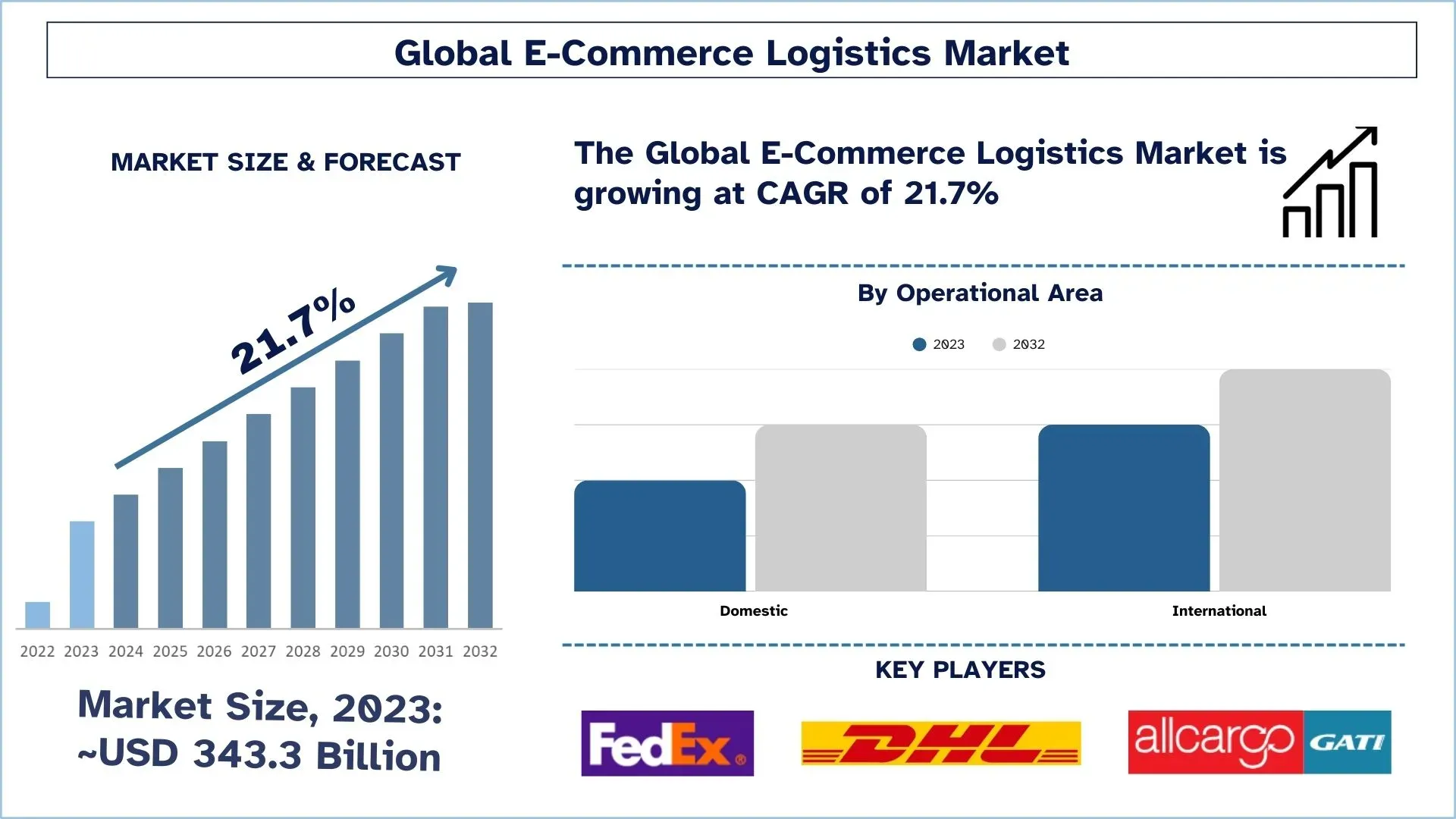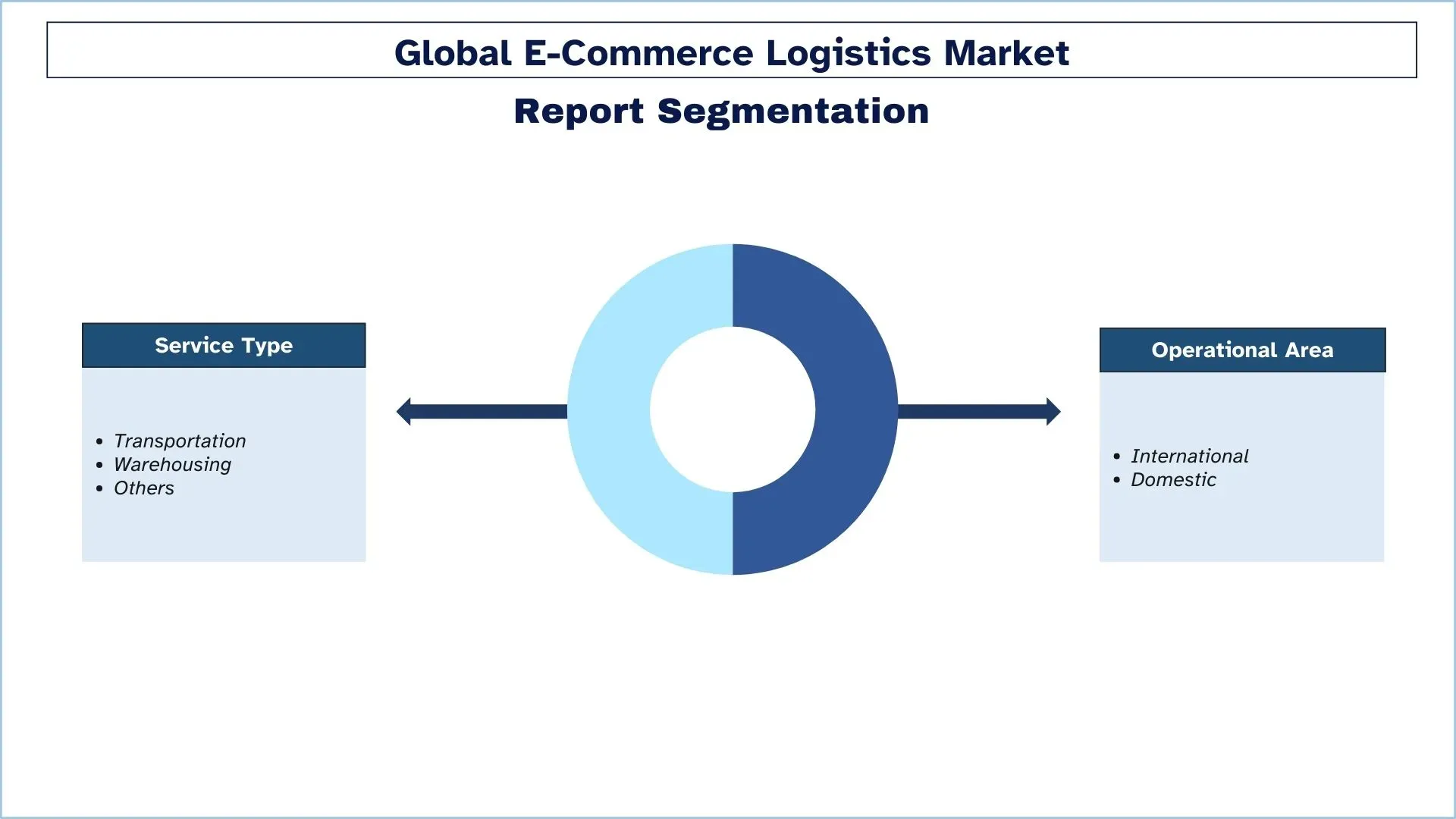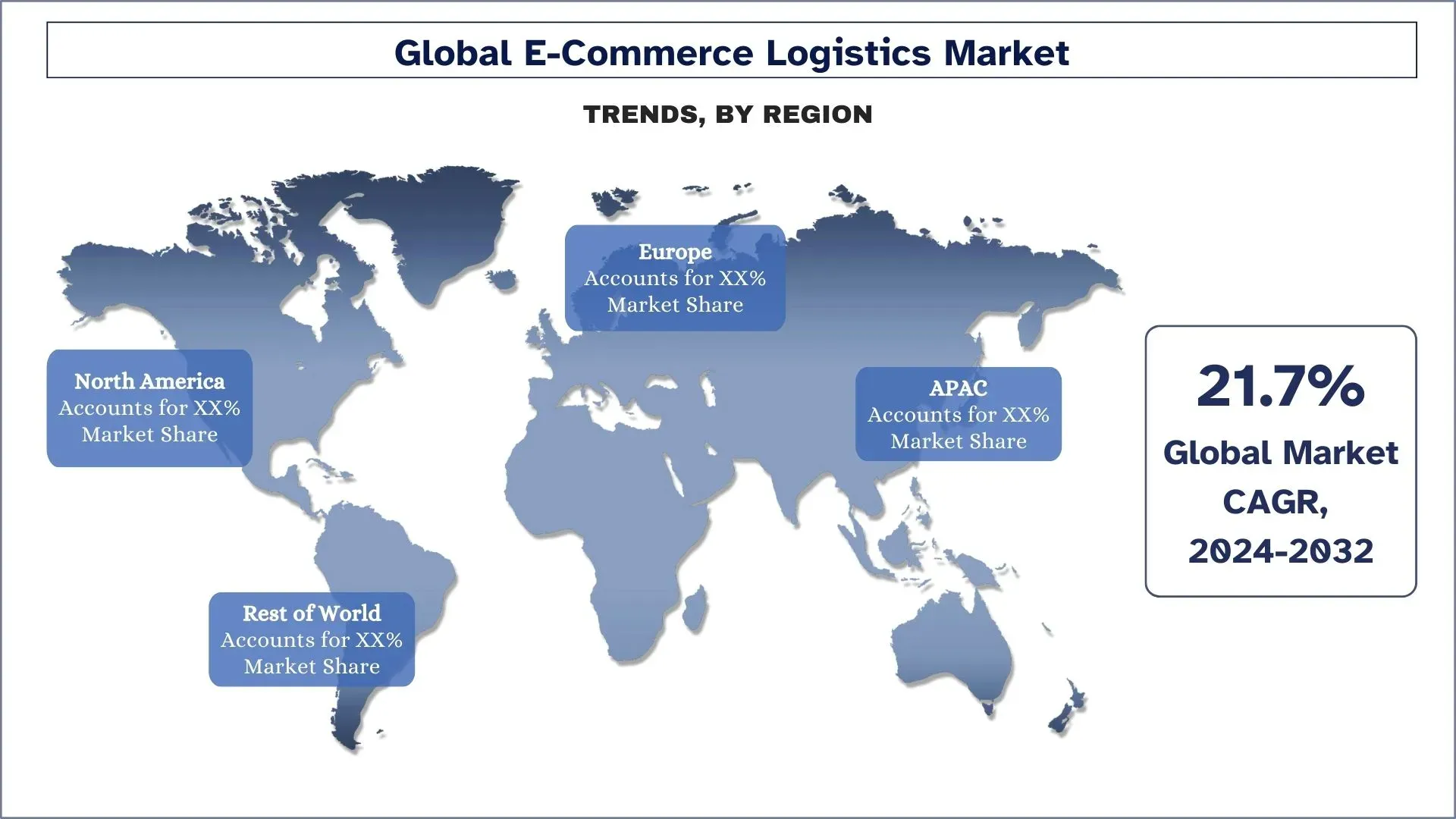- Home
- About Us
- Industry
- Services
- Reading
- Contact Us
E-Commerce Logistics Market: Current Analysis and Forecast (2024-2032)
Emphasis on Service Type (Transportation, Warehousing, and Others); Operational Area (International and Domestic); and Region/Country

E-Commerce Logistics Market Size & Forecast
The E-Commerce Logistics market was valued at USD 343.3 billion in 2023 and is expected to grow at a robust CAGR of around 21.7% during the forecast period (2024-2032).
E-Commerce Logistics Market Analysis
E-commerce logistics is the process an e-commerce brand uses to get an order out the door and into the hands of the customer. After shoppers make an online purchase, the order is packed, shipped, delivered, and, in some cases, returned. Therefore, the increasing cross-border e-commerce activities and the growth of e-commerce startups are expected to drive e-commerce logistics. For instance, according to the Census Bureau of the U.S. Department of Commerce, the U.S. retail e-commerce sales for the first quarter of 2022, adjusted for seasonal variation but not for price changes, were $250.0 billion, an increase of around 2.4 percent from the fourth quarter of 2021. In addition, factors such as a major shift toward digital transformation, cloud deployment & technological advancement among small & medium businesses, and continuously ongoing modernization in workforce management strategy in emerging economies notably contribute toward the market growth.
E-Commerce Logistics Market Trends
This section discusses the key market trends that are influencing the various segments of the E-Commerce Logistics market, as identified by our team of research experts.
Market Trend in the E-Commerce Logistics Industry
The two trends, fast delivery and same-day or next-day delivery, emerge as the new directions ushered in specifically by e-commerce logistics demand. Self-employed retailers and third-party logistics are trying to advance the orders through automation, artificial intelligence-based route optimization, and strategically located stores for faster delivery. There is a set of industries, such as Amazon, Walmart, and Shopify, now incorporating intelligent warehousing solutions, applications powered by drones, and self-driving vehicles to satisfy the customer demand, where speed is currently defining the logistics industry progression.
E-Commerce Logistics Industry Segmentation
This section provides an analysis of the key trends in each segment of the global E-commerce logistics market report, along with forecasts at the global, regional, and country levels for 2024-2032.
The Transportation Segments Dominates the E-Commerce Logistics Market.
Based on service type, the market is segmented into transportation, warehousing, and others. Among these, the transportation category is expected to witness significant CAGR during the forecast period owing to the many advantages related to cost-effectiveness, quick and scheduled delivery, flexibility, tracking and tracing services, as well as free door-to-door shipping. Therefore, there is an increased demand for transport services within the e-commerce logistics market.
The International Segment holds the Largest Share of the E-Commerce Logistics Market.
Based on the operational area, the e-commerce logistics market has been classified into international, and domestic. The international category is expected to witness higher adoption of e-commerce logistics during the forecast period. This is mainly due to the small and medium enterprises having enlarged exports to increase their market share and increase their customer base. Also, the widespread use of C2C and B2C e-commerce websites has accelerated the demand for international and domestic e-commerce logistics.

APAC is expected to grow with a Significant CAGR during the Forecast Period.
In 2023, Asia-Pacific held a significant share of the global e-commerce logistics market. This is mainly attributed to the increase in internet penetration rate in emerging economies, as well as the rising disposable income that has contributed to the growth of the e-commerce market in the region. Further, Asia-Pacific is the home to more than 60 percent of the total population, and economically, it is the fastest-growing region among all the regions. China and India are home to around 2.8 Bn people, and they are the two countries with the fastest growth rate. This results in increased household income, and the growth of the e-commerce market depends heavily on the income of people. This means the e-commerce market is growing rapidly in the APAC region. Hence providing a massive market for the e-commerce logistics market players.
China Dominates the North American E-Commerce Logistics Market:
The e-commerce logistics market in China is the biggest globally, attributed to the leading players in the market, such as Alibaba, JD.com, and Pinduoduo, as well as the advanced adoption of digital payments. The use of smart warehouses, AI in supply chain and logistics, and smart delivery, like drones, self-driving vehicles, are some of the changes that are revolutionizing the efficiency in logistics. Also, the development of the third-tier city consumption group and cross-border e-commerce has created the demand for more optimized logistics systems that make China an innovative leader in the logistics industry in the world.

E-Commerce Logistics Industry Overview
The E-Commerce Logistics market is competitive and fragmented, with several global and international market players. The key players are adopting different growth strategies to enhance their market presence, such as partnerships, agreements, collaborations, new product launches, geographical expansions, and mergers and acquisitions. Some of the major players operating in the market are DHL (Deutsche Post AG); FedEx; Aramex; XPO Inc.; United Parcel Service of America, Inc.; AllcargoGATI Limited; Kenco Group; GXO Logistics, Inc.; SF Express; CEVA Logistics (CMA CGM)
Recent Developments in the E-Commerce Logistics Market
February 2024: Indian government declared the strategies to allocate funds towards strengthening the UPI infrastructure and promoting digital payments. This initiative is expected to further accelerate digital payment adoption across the country, which is likely to benefit the e-commerce logistics industry by encouraging more online shopping.
January 2024: UPS, one of the largest and most trusted global shipping and logistics companies, launched micro-hubs in major U.S. cities to facilitate same-day deliveries. This development of micro-fulfillment centers in urban areas assists in managing high-order volume and reducing delivery turnaround times in densely populated cities.
November 2022: CEVA Logistics signed a multi-year contract extension with ASOS. This contract aims to manage warehousing, e-commerce fulfillment, and inbound and outbound services for ASOS.
E-Commerce Logistics Market Report Coverage
Details | |
Base year | 2023 |
Forecast period | 2024-2032 |
Growth momentum | Accelerate at a CAGR of 21.7% |
Market size 2023 | USD 343.3 Billion |
Regional analysis | North America, Europe, APAC, Rest of the World |
Major contributing region | Asia-Pacific holds significant growth in the market. |
Key countries covered | U.S., Canada, Germany, United Kingdom, Spain, Italy, France, China, Japan, and India |
Companies profiled | DHL (Deutsche Post AG); FedEx; Aramex; XPO Inc.; United Parcel Service of America, Inc.; AllcargoGATI Limited; Kenco Group; GXO Logistics, Inc.; SF Express; CEVA Logistics (CMA CGM) |
Report Scope | Market Trends, Drivers, and Restraints; Revenue Estimation and Forecast; Segmentation Analysis; Demand and Supply Side Analysis; Competitive Landscape; Company Profiling |
Segments Covered | By Service Type, By Operational Area, Region/Country |
Reasons to Buy the E-Commerce Logistics Market Report:
The study includes market sizing and forecasting analysis validated by authenticated key industry experts.
The report briefly reviews overall industry performance at a glance.
The report covers an in-depth analysis of prominent industry peers with a primary focus on key business financials, product portfolios, expansion strategies, and recent developments.
Detailed examination of drivers, restraints, key trends, and opportunities prevailing in the industry.
The study comprehensively covers the market across different segments.
Deep dive regional-level analysis of the industry.
Customization Options:
The global E-Commerce Logistics market can further be customized as per the requirement or any other market segment. Besides this, UnivDatos understands that you may have your own business needs; hence, feel free to contact us to get a report that completely suits your requirements.
Table of Content
Research Methodology for the E-Commerce Logistics Market Analysis (2022-2032)
We analyzed the historical market, estimated the current market, and forecasted the future market of the global E-Commerce Logistics market to assess its application in major regions worldwide. We conducted exhaustive secondary research to gather historical market data and estimate the current market size. To validate these insights, we carefully reviewed numerous findings and assumptions. Additionally, we conducted in-depth primary interviews with industry experts across the E-Commerce Logistics value chain. After validating market figures through these interviews, we used top-down and bottom-up approaches to forecast the overall market size. We then employed market breakdown and data triangulation methods to estimate and analyze the market size of industry segments and sub-segments.
Market Engineering
We employed data triangulation techniques to finalize the overall market estimation and derive precise statistical numbers for each segment and sub-segment of the global E-Commerce Logistics market. We split the data into several segments and sub-segments by analyzing various parameters and trends, including service type, operational area, and regions within the global E-Commerce Logistics market.
The main objective of the Global E-Commerce Logistics Market Study.
The study identifies current and future trends in the global E-Commerce Logistics market, providing strategic insights for investors. It highlights regional market attractiveness, enabling industry participants to tap into untapped markets and gain a first-mover advantage. Other quantitative goals of the studies include:
Market Size Analysis: Assess the current and forecast market size of the global E-Commerce Logistics market and its segments in terms of value (USD).
E-Commerce Logistics Market Segmentation: The study segments the market by service type, operational area, and regions.
Regulatory Framework & Value Chain Analysis: Examine the regulatory framework, value chain, customer behavior, and competitive landscape of the E-Commerce Logistics industry.
Regional Analysis: Conduct detailed regional analysis for key areas such as Asia Pacific, Europe, North America, and the Rest of the World.
Company Profiles & Growth Strategies: Company profiles of the E-Commerce Logistics market and the growth strategies adopted by the market players to sustain the fast-growing market.
Frequently Asked Questions FAQs
Q1: What is the E-Commerce Logistics market's current market size and growth potential?
The global E-Commerce Logistics (AEB) market was valued at USD 343.3 billion in 2023 and is projected to grow at a CAGR of 21.7% from 2024 to 2032, driven by increasing safety regulations, advancements in AI-driven braking systems, and rising adoption of Advanced Driver Assistance Systems (ADAS).
Q2: What are the driving factors for the growth of the E-Commerce Logistics market?
Several factors are accelerating the growth of the e-commerce logistics industry, including:
• Surging Cross-Border E-Commerce: Increasing global trade and demand for international products are fueling the need for efficient logistics networks.
• Technological Advancements: AI-driven automation, smart warehouses, and real-time tracking enhance logistics efficiency.
• Growth in Direct-to-Consumer (DTC) Retail: More brands are bypassing traditional retail channels, increasing demand for fulfillment centers and last-mile delivery solutions.
Q3: Which segment has the largest E-Commerce Logistics market share by service type?
The transportation segment dominates the e-commerce logistics market, accounting for the largest share. This is due to the growing demand for efficient last-mile delivery, international shipping, and express parcel services. Companies are investing in route optimization, electric delivery fleets, and autonomous delivery solutions to meet rising consumer expectations for faster and more cost-effective shipping.
Q4: What are the emerging technologies and trends in the E-Commerce Logistics market?
The E-Commerce Logistics sector is evolving rapidly with several game-changing trends:
• AI-Driven Smart Warehouses: Major players like Alibaba’s Cainiao and JD Logistics are using robotic automation and predictive analytics to enhance efficiency.
• Autonomous & Drone Deliveries: Companies are testing self-driving delivery vehicles and drone-based shipping to reduce delivery time and costs.
• Sustainability & Green Logistics: There is a growing push for eco-friendly packaging, carbon-neutral shipping, and electric logistics fleets to reduce environmental impact.
Q5: Which region will dominate the E-Commerce Logistics market?
The APAC region is expected to dominate the market during the forecast period.
Q6. What are the biggest challenges in the global E-Commerce Logistics market?
Despite strong growth, the industry faces key challenges:
• High Costs of Last-Mile Delivery: Consumer demand for fast, free shipping increases operational expenses for logistics providers.
• Supply Chain Disruptions: Global events, trade restrictions, and geopolitical factors impact logistics efficiency.
• Scalability Issues: Growing order volumes require massive infrastructure investments in warehousing and transportation.
Q7: Who are the key players in the global E-Commerce Logistics market?
• DHL (Deutsche Post AG)
• FedEx
• Aramex
• XPO, Inc.
• United Parcel Service of America, Inc.
• AllcargoGATI Limited
• Kenco Group
• GXO Logistics, Inc.
• SF Express
• CEVA Logistics (CMA CGM)
Q8: How can businesses optimize their supply chain for faster and more cost-effective e-commerce logistics?
Businesses looking to streamline logistics operations and reduce costs should:
• Leverage AI and automation for demand forecasting, inventory management, and real-time tracking.
• Partner with 3PL providers to improve warehousing, fulfillment, and delivery efficiency.
• Implement micro-fulfillment centers and regional distribution hubs to reduce last-mile delivery costs.
• Adopt IoT-enabled fleet management systems to optimize route planning and fuel consumption.
Q9: What investment opportunities exist in the e-commerce logistics market for businesses and investors?
The E-Commerce Logistics industry offers multiple high-growth investment opportunities, including:
• Warehouse Automation & Robotics: AI-powered sorting systems and robotic fulfillment centers.
• Last-Mile Delivery Innovations: Autonomous vehicles, drone-based shipping, and smart lockers.
• Sustainable Logistics Solutions: Investments in electric fleets, carbon-neutral shipping, and eco-friendly packaging.
• Cross-Border E-Commerce Infrastructure: Expansion of international fulfillment networks and trade-friendly logistics hubs.
Related Reports
Customers who bought this item also bought










